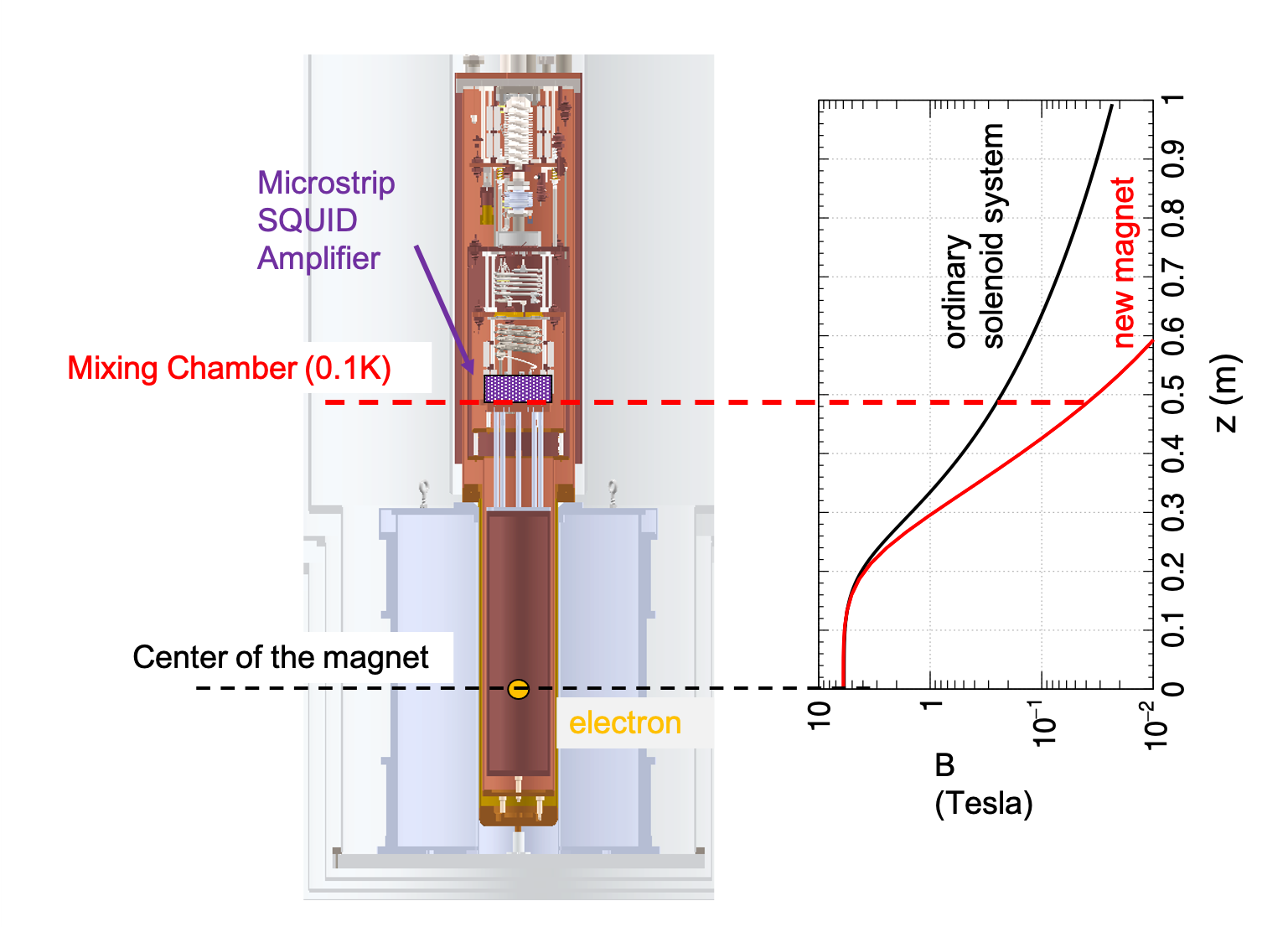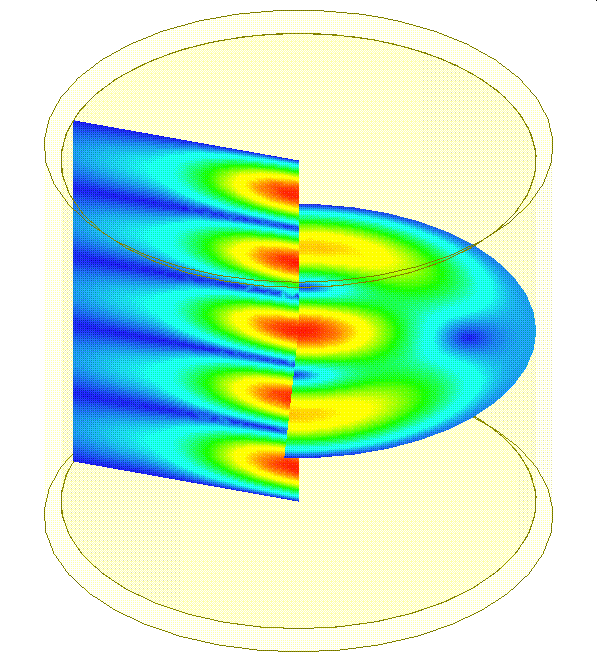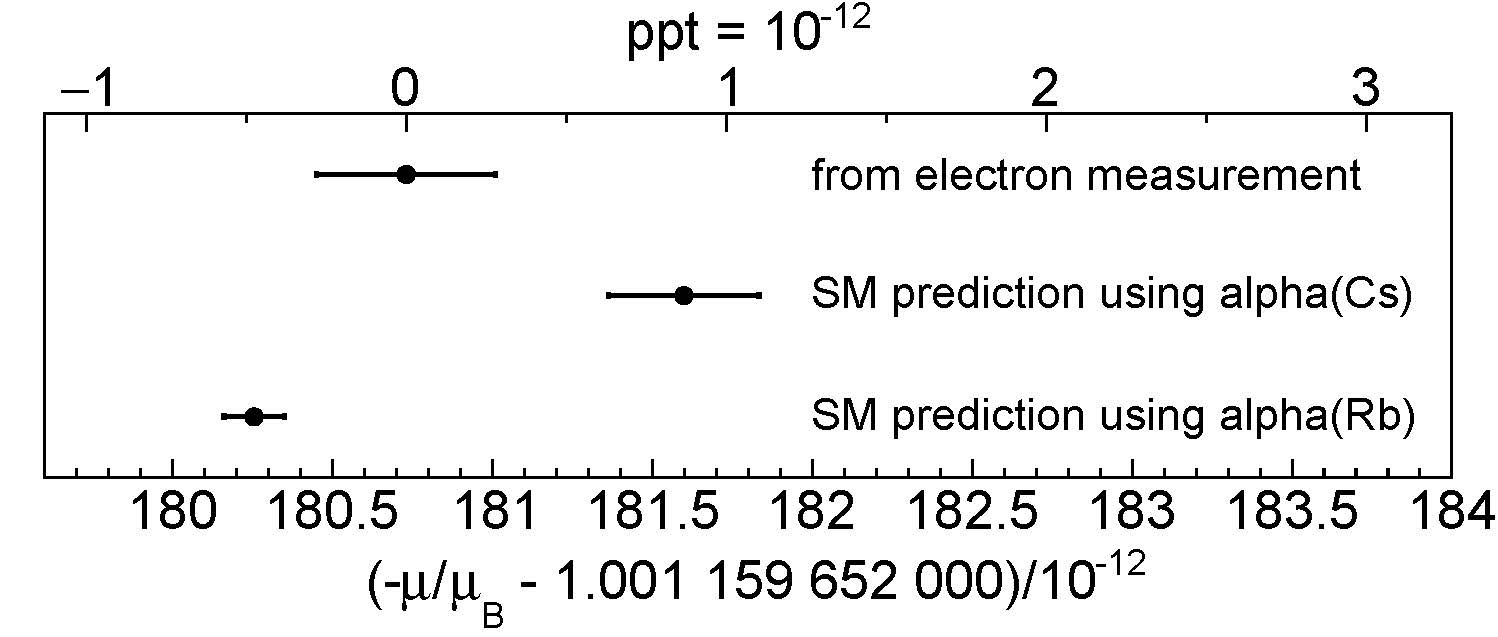
|

|

|

|

|
| Xing Fan | Benedict Sukra | Geev Nahal | Tom Myers | Gerald Gabrielse |
Goals: The electron and positron magnetic moments will be measured with a quantum cyclotron -- an isolated elementary particle whose lowest cyclotron and spin states can be resolved while it is isolated for months at a time. The electron magnetic moment will be measured 10 times more accurately. The less well-measured positron magnetic moment will be measured 150 times more accurately to compare to the electron magnetic moment more precisely by this factor.
(1) The first quantum lineshape calculations show that a new method to largely decouple a detection motion from its 0.1 K environment during one-quantum transitions will make it possible to evade detector backaction to measure the electron magnetic moment ten times more accurately.
"Driven One-Particle Quantum Cyclotron" X. Fan and G. Gabrielse, Phys. Rev. A 103, 022824 (2021)
"Backaction evasion" will be used to determine the quantum state of a one-particle system using QND methods that completely evade backaction, even that from the zero-point motion of the detection oscillator.
"Backaction circumvention" will avoid all but the backaction from the zero-point motion of the detection oscillator, despite the detector motion occupying some 20 quantum states. This is a new method that should greatly improve the precision of frequencies measured using quantum jump spectroscopy.
(3) A quantum cyclotron will be coupled to "quantum-limited" SQUID detector that bench tests indicate will heat the particle much less, will increase the detection efficiency, and will operate more robustly than conventional transistor detectors. A 200 MHz SQUID must be near to the particle but in a 60 times smaller magnetic field.

(4) A new solenoid is "actively shielded" to make this possible, and is "self-shielded" to cancel external field fluctuations.

(5) A unique gas 3He NMR probe, demonstrated at cryogenic temperatures, is ready for tuning the spatial homogeneity of the new solenoid.
(6) Extreme suppression of spontaneous emission from electron/positron cyclotron within extremely low loss trap cavities would enable much more precise magnetic moment measurements. Calculations with Fermilab collaborators are seeking optimal cavity designs to be tested in a cryogenic platform under development.

Calculated 145 GHz TE125 cavity fields that couple to the cyclotron motion of a centered e- or e+
Motivation: The electron and positron magnetic moment measurements will be the most precise measurements of properties of elementary particles. (1) They will make it possible to test the most precise prediction of the Standard Model of Particle Physics (SM). Crucial SM elements tested by the most precise confrontation of theory and experiment will include Dirac theory, quantum electrodynamics (QED), hadronic contributions, and weak contributions. (2) Owing to its fundamental CPT symmetry invariance, the SM predicts that the electron and positron moments are equal in magnitude but opposite in sign. The proposed measurements will be the most stringent test of CPT invariance with a lepton system. (3) The measurements and SM theory will provide the most precise determination of the fine structure constant.
A remarkable 1 part in 1012 agreement between the SM prediction and measurement has persisted for a decade. Intriguing discrepancies recently emerged at a slightly higher precision when two new measurements of the fine structure constant were used with SM theory to predict the magnetic moment.
A ten times more accurate measurement of the electron magnetic moment is critical for establishing whether the SM is able to make predictions that agree with measurement to 3 parts in 1014, or whether we have found the first evidence for BSM physics.

The Standard Model, the most fundamental description of physical reality, is the great triumph and great frustration of modern fundamental physics. All SM predictions that have been tested in a laboratory have been confirmed -- the electron magnetic moment being arguably its greatest triumph. At the same time, the SM is not able to account for basic features of the universe so something significant is missing.
The CPT invariance of the SM, for example, indicates that the big bang would produce essentially equal amounts of matter and antimatter which would then annihilate each other as the universe cools -- contrary to what we observe. The SM also cannot explain why it is made of matter rather than antimatter.
The most accurate value for fine structure constant will be a critical component of the basic system of units needed by a technological society.
References:
[1] Our research group, Phys. Rev. Lett. 100, 120801 (2008)
[2] Berkely group, Science 360, 191 (2018)
[3] Orsay group, Nature 588, 61 (2020)
[4] For example, Phys. Rev. D 98, 075011 (2018), Phys. Rev. D 98, 113002 (2018), Phys. Rev. D 99, 095034 (2019), Phys. Rev. D 102, 075016 (2020)
We are grateful to the NSF for funding the electron and positron magnetic moment measurements. Without their long-term, faithful support, difficult measurements with such an unusual precision could not possibly succeed. The development of quantum-limited detectors for use in magnetic moment measurements is supported by the Templeton Foundation. The development of low loss microwave trap cavities for use in magnetic moment measurements is supported by the DOE SQMS Center. The graduate work of X. Fan is partially supported by the Masason Foundation.
© 2021 - Last Updated: 02/19/2021 - Disclaimer